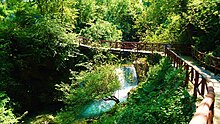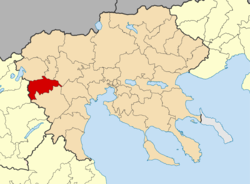
Back ناوسا Arabic ناوسا ARZ Негуш Bulgarian Náousa (kapital sa munisipyo) CEB Nausa Czech Нѣгоушь CU Naousa (Imathia) Danish Naoussa (Imathia) German Νάουσα Greek Nausa Spanish
This article has multiple issues. Please help improve it or discuss these issues on the talk page. (Learn how and when to remove these template messages)
|
Naousa
Νάουσα | |
|---|---|
 Naousa | |
| Coordinates: 40°38′N 22°4′E / 40.633°N 22.067°E | |
| Country | Greece |
| Administrative region | Central Macedonia |
| Regional unit | Imathia |
| Area | |
| • Municipality | 425.5 km2 (164.3 sq mi) |
| • Municipal unit | 300.9 km2 (116.2 sq mi) |
| Elevation | 330 - 480 m (−1,240 ft) |
| Population (2021)[1] | |
| • Municipality | 30,054 |
| • Density | 71/km2 (180/sq mi) |
| • Municipal unit | 19,706 |
| • Municipal unit density | 65/km2 (170/sq mi) |
| Time zone | UTC+2 (EET) |
| • Summer (DST) | UTC+3 (EEST) |
| Postal code | 592 00 |
| Area code(s) | 23320 |
| Vehicle registration | ΗΜ |
| Website | www.naoussa.gr |
Naousa (Greek: Νάουσα, historically Νάουσσα - Naoussa; Aromanian: Naustã), officially The Heroic City of Naousa is a city in the Imathia regional unit of Central Macedonia, Greece. It is located at the foot of the Vermio Mountains. According to the 2021 census its population was 19,706 inhabitants. The wider municipality, after the administrative reform of the Kallikratis plan, had a population of 30,054 inhabitants. Since 1955, by royal decree, it has been designated as a heroic city for the struggle and sacrifices of the inhabitants in 1822, during the Greek War of Independence.





An industrial center since the 19th century, for most of the 20th century the history of Naousa was closely intertwined with that of the Lanaras family, local industrialists who, at the height of their influence, employed almost half of Naousa's population in their textile factories.[2] The Lanaras family built hospitals, social centers etc. while streets of Naousa were named after family members. In the 1990s and 2000s however, most of the local factories closed, leaving Naousa with a serious (and still unresolved) unemployment problem.[2]
The Arapitsa of Naoussa is one of the few rivers in Greece that has a feminine name; the river that has gone down in history for the great sacrifice of the city's women in April 1822, who preferred that they and their children fall into its water rather than into the hands of the Turks. At the site of the women's sacrifice, in the Stoubanoi area next to the Arapitsa river, there is a monument.
- ^ "Αποτελέσματα Απογραφής Πληθυσμού - Κατοικιών 2021, Μόνιμος Πληθυσμός κατά οικισμό" [Results of the 2021 Population - Housing Census, Permanent population by settlement] (in Greek). Hellenic Statistical Authority. 29 March 2024.
- ^ a b "Εγκλωβισμένη στα τείχη της κλωστοϋφαντουργίας η κοινωνία της Νάουσας | Η ΚΑΘΗΜΕΡΙΝΗ". 2 October 2004.
© MMXXIII Rich X Search. We shall prevail. All rights reserved. Rich X Search


